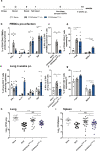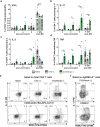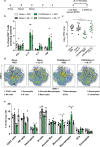Mucosal delivery of a multistage subunit vaccine promotes development of lung-resident memory T cells and affords interleukin-17-dependent protection against pulmonary tuberculosis
- PMID: 33298977
- PMCID: PMC7665186
- DOI: 10.1038/s41541-020-00255-7
Mucosal delivery of a multistage subunit vaccine promotes development of lung-resident memory T cells and affords interleukin-17-dependent protection against pulmonary tuberculosis
Abstract
The development of effective vaccines against bacterial lung infections requires the induction of protective, pathogen-specific immune responses without deleterious inflammation within the pulmonary environment. Here, we made use of a polysaccharide-adjuvanted vaccine approach to elicit resident pulmonary T cells to protect against aerosol Mycobacterium tuberculosis infection. Intratracheal administration of the multistage fusion protein CysVac2 and the delta-inulin adjuvant Advax™ (formulated with a TLR9 agonist) provided superior protection against aerosol M. tuberculosis infection in mice, compared to parenteral delivery. Surprisingly, removal of the TLR9 agonist did not impact vaccine protection despite a reduction in cytokine-secreting T cell subsets, particularly CD4+IFN-γ+IL-2+TNF+ multifunctional T cells. CysVac2/Advax-mediated protection was associated with the induction of lung-resident, antigen-specific memory CD4+ T cells that expressed IL-17 and RORγT, the master transcriptional regulator of Th17 differentiation. IL-17 was identified as a key mediator of vaccine efficacy, with blocking of IL-17 during M. tuberculosis challenge reducing phagocyte influx, suppressing priming of pathogen-specific CD4+ T cells in local lymph nodes and ablating vaccine-induced protection. These findings suggest that tuberculosis vaccines such as CysVac2/Advax that are capable of eliciting Th17 lung-resident memory T cells are promising candidates for progression to human trials.
Conflict of interest statement
N.P. is the research director for Vaxine P/L. E.L.S. was an employee of Vaxine P/L. The remaining authors declare that they have no competing interests.
Figures







Similar articles
-
Delta inulin-based adjuvants promote the generation of polyfunctional CD4+ T cell responses and protection against Mycobacterium tuberculosis infection.Sci Rep. 2017 Aug 17;7(1):8582. doi: 10.1038/s41598-017-09119-y. Sci Rep. 2017. PMID: 28819247 Free PMC article.
-
Advax adjuvant formulations promote protective immunity against aerosol Mycobacterium tuberculosis in the absence of deleterious inflammation and reactogenicity.Vaccine. 2021 Apr 1;39(14):1990-1996. doi: 10.1016/j.vaccine.2021.02.041. Epub 2021 Mar 11. Vaccine. 2021. PMID: 33714652
-
Combination Adjuvants Enhance Recombinant Protein Vaccine Protection against Fungal Infection.mBio. 2021 Aug 31;12(4):e0201821. doi: 10.1128/mBio.02018-21. Epub 2021 Aug 17. mBio. 2021. PMID: 34399628 Free PMC article.
-
[Novel vaccines against M. tuberculosis].Kekkaku. 2006 Dec;81(12):745-51. Kekkaku. 2006. PMID: 17240920 Review. Japanese.
-
Functional Signatures of Human CD4 and CD8 T Cell Responses to Mycobacterium tuberculosis.Front Immunol. 2014 Apr 22;5:180. doi: 10.3389/fimmu.2014.00180. eCollection 2014. Front Immunol. 2014. PMID: 24795723 Free PMC article. Review.
Cited by
-
Advance in strategies to build efficient vaccines against tuberculosis.Front Vet Sci. 2022 Nov 24;9:955204. doi: 10.3389/fvets.2022.955204. eCollection 2022. Front Vet Sci. 2022. PMID: 36504851 Free PMC article. Review.
-
Virulence Mechanisms of Mycobacterium abscessus: Current Knowledge and Implications for Vaccine Design.Front Microbiol. 2022 Mar 3;13:842017. doi: 10.3389/fmicb.2022.842017. eCollection 2022. Front Microbiol. 2022. PMID: 35308378 Free PMC article. Review.
-
A Structural View at Vaccine Development against M. tuberculosis.Cells. 2023 Jan 14;12(2):317. doi: 10.3390/cells12020317. Cells. 2023. PMID: 36672252 Free PMC article. Review.
-
Boosting BCG with recombinant influenza A virus tuberculosis vaccines increases pulmonary T cell responses but not protection against Mycobacterium tuberculosis infection.PLoS One. 2021 Nov 18;16(11):e0259829. doi: 10.1371/journal.pone.0259829. eCollection 2021. PLoS One. 2021. PMID: 34793507 Free PMC article.
-
Tertiary Lymphoid Structures in Tuberculosis: Persistence, Protection, and Pathology.Immunol Rev. 2025 Aug;333(1):e70055. doi: 10.1111/imr.70055. Immunol Rev. 2025. PMID: 40815083 Free PMC article. Review.
References
-
- World Health Organisation. Global Tuberculosis Report 2019 (WHO, 2019).
Grants and funding
LinkOut - more resources
Full Text Sources
Research Materials

